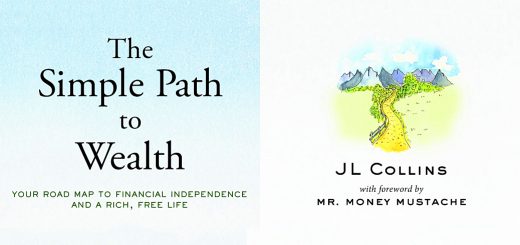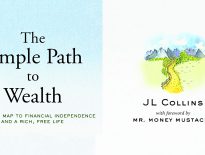The Simple Path to Wealth

Today we look at a new investment book – The Simple Path to Wealth by JL Collins.
Contents
The Simple Path to Wealth
JL Collins has written a book.
- Who’s he, you say?
Well you might know him as successful US blogger Jim Collins.
- He’s styled himself JL for this book, as it turns out there’s already a successful author by the name of Jim.
JL’s website, and in particular his Stock Series of posts, grew out of a series of letters he wrote to his teenage daughter, advising her on how to run her financial life.
- She agreed with JL that money was important, but she didn’t want to spend her life thinking about it.
- So he had to keep things simple, and entertaining
JL has the right kind of credentials for a finance blogger- he’s done it himself, through regular work and investment, and is now retired.
- He didn’t get rich through his blog.
That said, JL’s blog is pretty popular these days – so popular in fact that the forward to the book is written by Mr Money Mustache, probably the most successful personal finance blogger of them all.
- JL kindly sent me a copy of the book to review, so here goes.
The Golden Rules
JL starts the book with some key guidelines, which I’ve simplified below:
- Avoid debt.
- Spend less than you earn – aim to save 50% if you can.
- Invest the surplus in the stock market and reinvest the dividends.
- You have to understand that the stock market will have big falls from time to time – don’t worry.
- Avoid “fiscally irresponsible people” – don’t marry one or allow them access to your money.
- Avoid investment advisers – by the time you can pick a good one, you can handle your own finances.
- The things you own also own you.
- Financial independence – when you can live off 4% of your investments per year – is all about freedom and choices, not luxury.
I think the book has pretty much paid for itself right there.
- This stuff can take decades to learn on your own.
F-You money
Central to JL’s philosophy is the building up of “F-You” Money.
- When you don’t need money to live on, you’re free to pursue whatever options take your fancy, without thinking about what other people say.
- As well as the money to live on, you’ll need to clear your debts.
- And the more modest a lifestyle you can cope with, the easier it will be to reach your target.
You need to stop thinking about what your money can buy, and start thinking about what your money can earn.
- When you do think about spending, consider the “opportunity costs” – how much money you would have in the future if you didn’t spend.
- That’s the real cost of what you want.
This is related to the magic of compounding.
- When a twenty-something buys a £2 coffee, they’re really spending £6 or £7 of their money in retirement.
Debt
JL doesn’t like debt – he talks about the high cost of credit card debt and car loans.
- He’s more positive on mortgages, though he counsels not to buy “too much house.”
- He also explains how to pay debt off.
I don’t like debt either.
- Debt is borrowing money from your future, when you will need it more.
- The only acceptable debt is that on an appreciating asset.
- Here in the UK, that means a mortgage on a house.
- A house is tax advantaged (exempt from capital gains tax) in the UK, so “too much house” is not so much of a risk.
The One-Fund Portfolio
JL recommends putting all your eggs in one basket.
The basket he prefers is $VTSAX – the Vanguard Total Stock Market Index Fund.
- This is a widely spread index of US stocks.
- JL is a big fan of Vanguard and its founder Jack Bogle, and devotes an entire chapter to explaining why.
- Later in the book there a second chapter on index funds, and the bad press that they get
He also approves of a bond fund ($VBTLX – the Vanguard Bond Market Index fund) and of cash, but only once you’ve built your pot and are taking money from it.
- JL’s “Wealth Preservation” portfolio is 75% US stocks, 20% US bonds and 5% cash.
He doesn’t like international funds, because the US market earns so much of its money abroad anyway.
- If you must have international exposure, he recommends three other Vanguard funds ($VFWAX, $VTIAX and $VTWSX).
I prefer a much more diversified portfolio, and one that includes active funds as well – more on this below.
Target Date Funds
JL likes Target Date Funds (called TRFs or Target Retirement Funds by Vanguard).
- These funds increase your bond allocation – and reduce your stock allocation – as you close in on your specified retirement age.
For a while I thought TRFs were a good thing.
- When UK investors were forced to buy an annuity on retirement (at age 55 or 60 or 65), having your bond allocation automatically increase – to protect you from a market crash just before your purchase – seemed like a good idea.
Then in 2005 Gordon Brown said you didn’t need to buy an annuity until age 75.
- Suddenly having a lot of bonds for 20 years plus didn’t seem so clever.
- And now you never need to buy an annuity at all.
I’ve come back to a half-way house position these days.
- The problem is with the name – I don’t want to increase my bond allocation before I hit retirement age (age 55, say).
- I want to increase my bonds when I might buy an annuity.
So the way to use TRFs is to target a much older age – 75, say – rather than your actual retirement age.
- With 30 years of retirement ahead of you, you need to hang on to your stocks.
Why Most People Lose
JL has a good section in the middle of the book on the psychology of investing, and how it trips people up.
He identifies four reasons why people don’t do as well as they should:
- they think that they can time the market
- they think that they can pick individual stocks (there’s a whole chapter later in the book on why this is impossible)
- they think that they can pick winning fund managers
- they pay too much attention to day-to-day market noise, or what JL calls the “foam on the top of the beer”
He looks at the 1929 stock market crash and the ensuing depression to demonstrate that regular investment and buy-and-hold can work.
I’m afraid that I’m guilty of three of these four sins, though they haven’t affected my performance over the past 30 years:
- there are ways (like the CAPE, or market cap to GDP) to tell when the market is a good or a bad bet
- you can successfully screen for value or momentum stocks, or focus on stocks too small for institutional investors, though it’s time-consuming, and I personally believe that how you manage your portfolio after the initial buy is more important
- there are consistently winning managers, typically accessed here in the UK via investment trusts
None of this invalidates JL’s approach.
- There’s more than one route to financial success, and everyone needs to find one that works for them.
Other Chapters
The book has a chapter that covers a case study of how to put his strategy into practice for a 26-year-old.
- This looks at the result from two levels of savings rates: 24% and 50%.
The book also has a chapter on why JL doesn’t like investment advisers.
- They basically cost more than doing things yourself, a conclusion with which I heartily agree.
There’s also a section on why lump sum investing beats dollar cost averaging (drip-feeding).
- Again, I agree.
The final chapters of the main section of the book cover:
- how (not) to be a TV stock pundit
- how to avoid being conned into a bad investment
How to Spend It
The last part of the book is about spending your money once you have your pot.
JL covers safe withdrawal rates (SWAs – he prefers much higher ones than me, though he agrees that 3% pa is very safe) and how to take your money out (this is US-specific).
He also looks at Social Security (the equivalent of our State Pension) and at setting up a Charitable Foundation.
The book ends with some personal anecdotes.
- First, about how his daughter has progressed since he first wrote her those letters – she’s doing fine.
- Second, about some guys he met in the South Pacific many years ago. They had a big impact on him financially.
The closing chapter compares risk and volatility (they aren’t the same thing, despite what the professors would tell you).
Quibbles
I don’t agree with JL about everything.
He believes that complex investments are created simply to make money for those who peddle them.
- I agree that the finance industry serves its firms and employees better than it’s customers, but I think there are advantages – in term’s of risk management and volatility – to using more sophisticated products than simple index trackers.
- You have to be careful, and you have to know what you are doing in the first place – plus you need to have the time and energy to keep on top of things – but there are benefits.
He also thinks that 4% pa is a safe withdrawal rate (SWA).
- It certainly would have been in the past, but perhaps no longer.
- JL uses the 40-year period from 1975 to 2015 for his analysis – that’s when Jack Bogle launched the first (Vanguard) index fund, and it’s also when JL started investing.
- The US market returned 11.9% pa over those 40 years. (After inflation it was 7.8% pa, and without reinvesting dividends, it fell to 4.7% pa).
- That’s a staggering return, and one that would support an SWA far higher than 4%.
- But we won’t see 11.9% returns over the next 40 years. ((JL does clearly point this out ))
- I’ll come back to this is a future article, but recent research and future growth projections suggest that using 3.5% or even 3% pa would be much more sensible, particularly in the UK.
JL also ignores taxes, inflation and fees in his projections and calculations.
- Inflation is unpredictable, and because he recommends mostly stock market investments, he’s pretty well hedged in any case.
- Similarly, because he recommends low-cost index funds, his fees will be low whether he focuses on them or not.
But taxes make a big difference.
- I’m not that familiar with the US tax system – I think they have more tax band (state and federal) and more deductions than we do.
- Perhaps your tax calculation in the US is really so individual as to be beyond the scope of a personal finance book.
- JL does have sections on the US tax shelters and withdrawal rules (401k, 403b, TSP, IRA, Roth, HSAs and RMDs) but I’m not familiar with these accounts and regulations.
Here in the UK the tax regime (for people earning less than £100K) is pretty simple and very benign.
- You need to take up your employer matched pension contribution, then fill up your SIPP, and then your ISA.
- This will make a massive difference to the size of your pension pot at retirement, perhaps doubling it.
And JL doesn’t believe in diversification.
- He puts everything in the US market, in a single passive tracker fund.
Not only is that a lot of home bias, it’s the wrong home bias for those of us who live in the UK.
- If your expenses are largely in pounds, you don’t want to be fully invested in dollars.
- Even a global or “World” fund will be 50% invested in the US.
- A UK investor probably shouldn’t have more than about 5% to 7% of their net worth in US stocks.
I’m a firm believer in widely-diversified multi-asset portfolios.
- Yes, they are a bit more work than a single fund – you have to re-balance the allocations once a year – but these days they are simple and cheap to construct using ETFs.
- Not only will you get higher returns over the long-run, you’ll get lower volatility and smaller pullbacks (downturns) along the way.
- Which means that you can sleep more easily.
I also think that there are problems with passive index funds.
- Specifically, they are usually market cap weighted, which means that they overweight firms that have done well (large firms) and underweight those more likely to do well in the future (smaller firms).
- I recommend a hybrid passive / active approach, with the active elements directed at “factors” with proven historic outperformance (value, momentum, small companies, low volatility etc).
Conclusions
JL’s book is obviously focused on the American market, and it offers a much simpler strategy than we cover here at 7 Circles.
Nevertheless, for the right audience, JL’s book has the potential to be life-changing.
- The book is written in an approachable, folksy style, with lots of anecdotes and personal examples.
- JL also covers the mental and emotional aspects of investing, which are just as important as the basic techniques.
- And he isn’t trying to sell you anything (apart from the book, of course).
- The methodology – which you could summarise as “avoid debt, spend less than you earn, and invest wisely” – is so simple that anyone could do it, and it doesn’t take up as much of your time as more complicated approaches.
Lots of people find investing overwhelming, and if a simple strategy can get people started down the right road, that’s a great thing.
- Confidence is a real stumbling block for many people, and that’s where a book like this can help.
A one-fund portfolio might not appeal to the majority of my readers, but you probably know somebody who could be helped by reading this book.
- Why not do them a favour and buy them a copy?
There’s more than one way to wealth, but this is surely one of them.
- And as it says on the cover, it’s a simple one.
Until next time.

















Thanks for great article.
How to invest in the VTSAX in the UK?
I’ve no idea, but why would you want to? Use a UK-listed ETF for your exposure to the US.
Mike